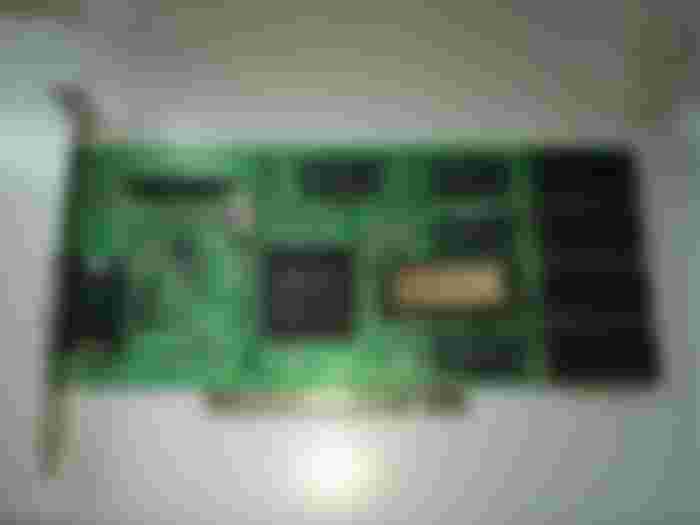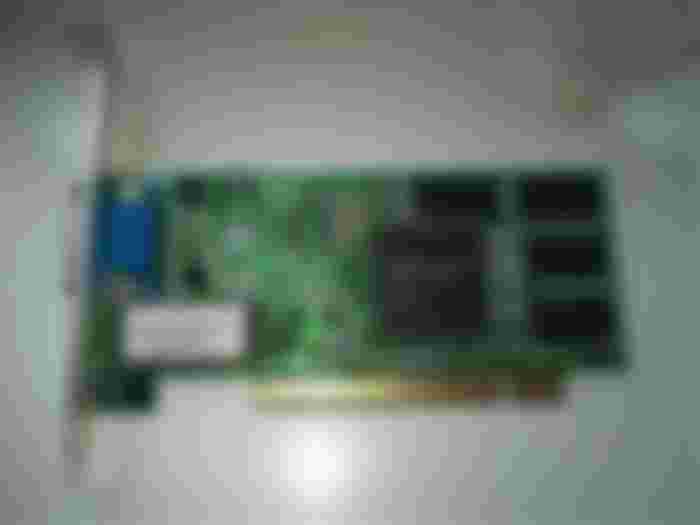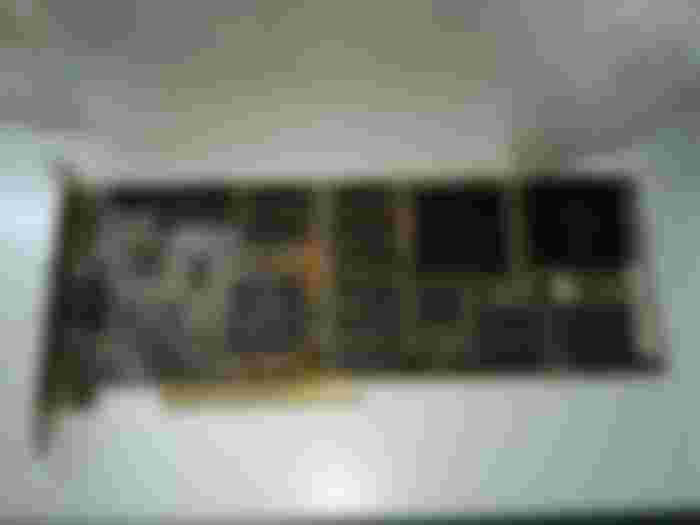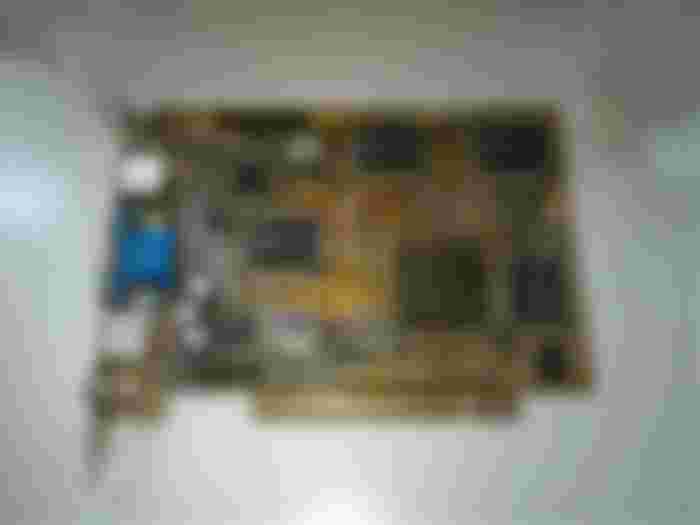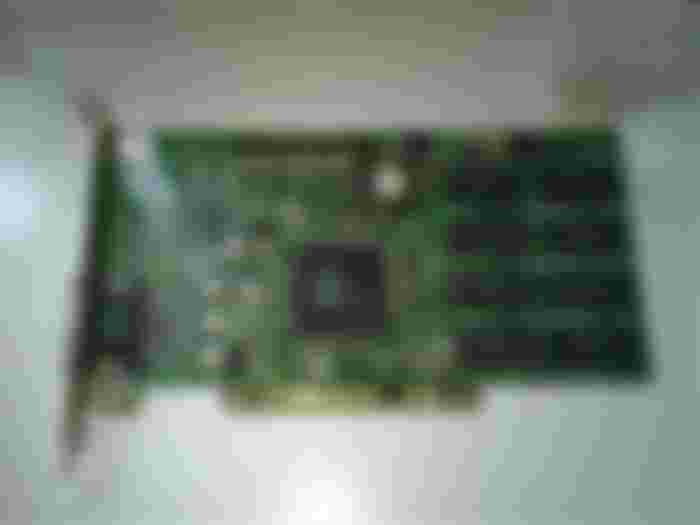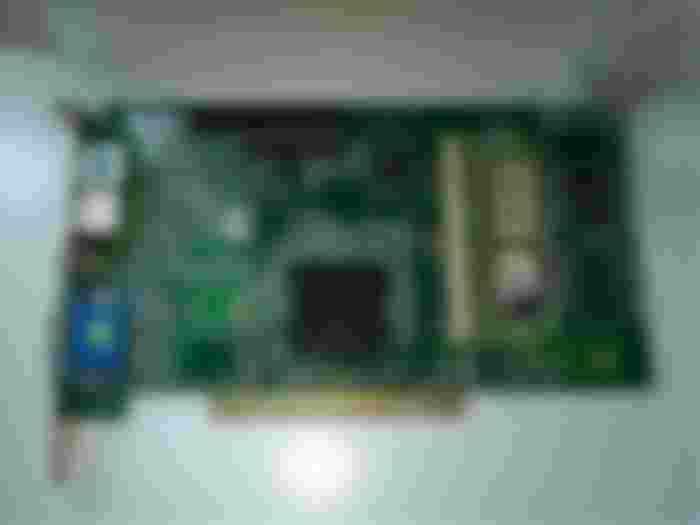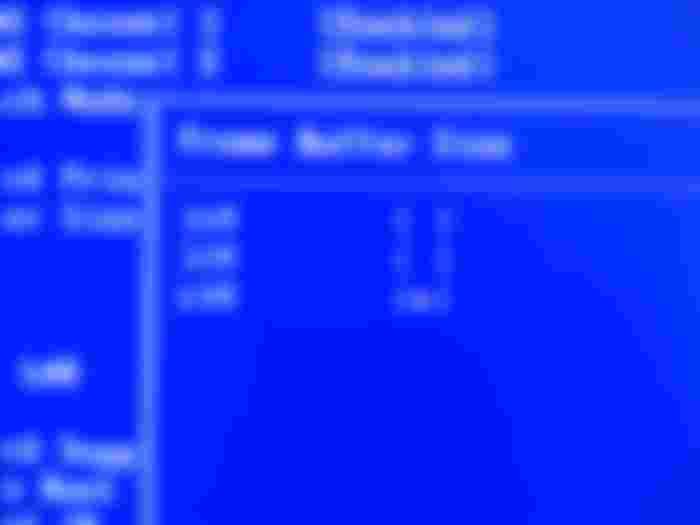Gaming without an AGP port after 2000
The AGP port was introduced in 1997. Before this, most 3D cards used the PCI port, but most of the graphics card manufacturers decided to switch to AGP. Even the existing products got an AGP version, and PCI video cards got slowly phased out by the end of the year. Motherboard manufacturers, however, decided not to include an AGP port on cheaper OEM motherboards. If a motherboard had an integrated graphics card, it usually had no AGP. The integrated video card was usually unusable to gaming, or any sort of 3D. They frequently used 2D-only chips, which was only usable to office-type use, or watching movies at most. If someone wanted to use his older motherboard, that also had no AGP port on it. Due to this, a lot of people got stuck with motherboards without an AGP port, and due to this, they had a hard time to find a high-end 3D graphics card.

The AGP port
The AGP port (Accelerated Graphics Port) was a dedicated port for graphics cards, used from 1997 to 2004, when it was replaced with the new PCI-E standard. AGP offered higher bandwidth, fast access to textures in the system memory, increased power delivery up to 45W.

The AGP port was not backwards compatible with the PCI port due to different number of pins. An AGP-capable chip was able in PCI signaling mode, which would have allowed to produce PCI graphics cards with the new 3D chips as well, but barely any manufacturers bothered to do so. AGP 4x and 8x got introduced later, allowing even faster speeds. The new AGP 8x used lower voltage. To make things worse, AGP 8x motherboards are therefore not backwards compatible with the early 3.3v 1x/2x AGP cards, and AGP 8x-only cards can not be inserted to 3.3v AGP 1x/2x motherboards.
The problem is getting worse
Any typical Socket 7 motherboard lacked an AGP port, till the new Super Socket 7 standard arrived, which could be equipped with an AGP port. But it was too expensive, any almost no one had it. Cheap OEM Intel Celeron based motherboards usually had no AGP port as well. Even as the Pentium 3 generation arrived, and clock speeds got ramped up to around 1 GHz, cheap motherboards not only lacked an AGP port, but got frequently equipped with Trio64 based integrated graphics chips - without any form of 3D. Games usually didn't included a software renderer any more, and the computers were unusable for gaming. Integrated Intel and SiS chips got better in 3D by 1999, but as they got their RAM from the system memory, the weak memory bandwidth didn't allowed high frame rates and resolutions. Such designs were not able to run properly the games with high CPU demand, as the game engine itself also needed the bandwidth of the system memory. The issue persisted, even when the SD and EDO memory got replaced by DDR, until dual channel memory controllers started to be regularly used on the latest Athlon XP and Pentium 4 motherboards - precisely in the year when PCI-E got introduced, and AGP itself became obsolete.
New PCI cards were expensive
PCI cards were still available, as some manufacturers made them - for a price. The demand was small, but gamers needed the card. This meant high prices for the PCI models. These modern cards with PCI variation were available in the price list of the stores, but when you wanted to buy it, they either had no idea what you are talking about, or they were sold it out months ago. If the PCI version of a card was available, it was usually 3 to 4 times more expensive than the AGP model. This was true to the PCI version of the TNT2 M64, and even the GeForce2 mx200 got released as a PCI unit. The same goes with ATi, which effectively stopped making PCI cards after the Rage2+, and if they had a PCI model, it was usually the very expensive AIW model with built-in tv-tuner. 3dfx was less reluctant to produce PCI based Voodoo cards, but their PCI cards still were far more expensive than the AGP variants. They were not able to produce too much cards due to their imminent bankruptcy, which again, means, even if Voodoo cards were available on price lists, you couldn't buy them in the stores any more. Manufacturers like Intel, S3 and SiS mostly focused on their integrated business, and fighting the anemic speed problems discussed above. Even if desktop graphics cards were made based on their chips, it was usually AGP. Companies like PowerVR, 3Dlabs and Matrox also put their bets to AGP.
Old PCI cards became expensive as well
As the PCI variations of newer video cards were only availalbe in theory, but not in practice, people were trying to buy up the usable older PCI video cards from the market. As the number of gamers increased in the 2000s comrated to the late 90s, it was an impossible to find a card for everyone. Potato-class PCI graphics cards were easy to come by, older flagship models went for premium price. The price of used older PCI 3D graphics cards barely decreased, and the shortage of PCI 3D cards never got solved until the end of the AGP era.
The cards
In this test, i am going to feature and benchmark all the frequently available PCI video cards of the early 2000s era. On a side note, some PCI cards got released even after the begin of PCI-E era, such as the GeForce 520 PCI, GeForce 610 PCI, or Radeon HD 2400PCI. Those are not going to be featured in the test, as those belong to the 64 bit era with dual CPUs, and targeting mostly the HTPC users.
S3 Virge DX PCI
The S3 Virge DX was the updated model of the very first OEM 3D accelerator of the world: the S3 Virge. This card were available for $20 in early 2000s on second hand markets. It was a very popular video card in its time, got produced in large quantities. It got quickly replaced in 1997 by stronger cards. This meant the card was available in large numbers. I have tested this card multiple times in its own era of early graphics cards, and it was one of the slowest graphics card.
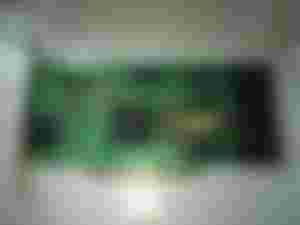
This time, it will get a stronger processor, which might allows it to perform well, even without a hardware triangle setup engine. The card is equipped with 4 MB video memory, which is an absolutely must-have after 2000. One giant adventage of the card is the flawless Windows XP support, so if someone decided to update to XP early on, the owner of the card didn't had to replace it. A giant disadventage is the lack of native OpenGL support. It only supports 16-bit rendering.
S3 Trio3D PCI
This is the younger brother of the Virge DX, using the same, redesigned core. Its about twice as fast as its older brother, and its equipped with 8 MByte VRAM. This is the only card which was intentionally designed for low-end OEM computers without AGP. In the previous test, this card was unstable. It seems the card thought its an AGP card after all, as AGP acceleration was enabled all the way - causing hangs even on the desktop. Lets hope this issue will not repeat, as next time it will be tested in a more modern motherboard, with different chipset.
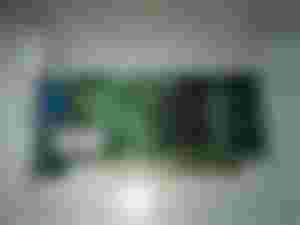
This card was about $20 second hand in early 2000s. Similarly to its older brother, it has good XP drivers, but no OpenGL support at all. The card feels very lightweight, and cheap - after all, that was the goal of this product. This card also supports 24-bit rendering, and bigger resolutions and textures.
3dfx Voodoo Rush PCI
The Voodoo Rush was the first attempt of 3Dfx to release a cheap OEM card. The video card combines a 2D chip, and a 3D chip on the same PCB. This card was cheap, available at $20 used. The performance of the card is somewhat lower than the Voodoo1, in other hand it usually has more memory, and can support larger resolutions. The card supports 16 bit rendering only, up to 800x600 under 3D. The drawbacks are the buggy drivers, and the size of the card itself: it can't be used in some motherboards, because there are not enough room behind the PCI slots.

The card doesn't properly supports Windows XP, only a beta driver with Glide and OpenGL available for XP, without D3D support. When the Rush works, it works very well. 3D rendering in a window also supported under D3D. The unit i have is a 6 MB model (4MB for the frame buffer, 2 MB for the textures). This means support for 800x600. As the card is a tiny bit slower than the Voodoo1, it wasn't a popular choice in the late 90s, but the optimized drivers of 3dfx could help it out in some titles.
3dfx Voodoo 3 2000 PCI
The Voodoo3 was one of the first real graphics card of 3dfx (integrating a 3D and a 2D core). The card got released in 1999, but the graphics features of the card are similar to other brands from 1996. 3dfx attempted to fight the aging TNT and TNT2 cards with this product, but it can't offer the features of the TNT series. It lacks support for large textures, so the texture sizes are limited to 256x256. The card also lacks support for 24 or 32 bit rendering. Instead of the features, 3dfx focused on the speed. And the performance of the card was indeed good, in pair with GeForce cards. The Voodoo3 line meant to occupy the high end, but ended up in the midrange instead. The card had adventages as well.
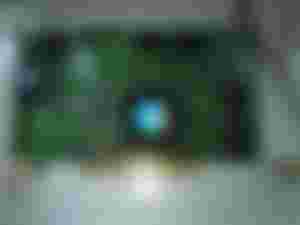
Unlike other manufacturers, 3dfx was willing to produce PCI variants of this card, so if someone had the money, was able to buy it. All variations of the Voodoo3 card initially use a passive heatsink, and its recommended to have active cooling to avoid damages to the chip. The card also has drivers for Windows XP, which makes it better alternative than some other cards in the list. The card has 16 MByte memory.
nVidia Riva 128 PCI
The first usable 3D card of nVidia, the Riva 128 PCI, was widely available for the PCI slot. When the card got released in 1997, it became the mortal enemy of 3dfx, and the speed of the card rivaled the Voodoo 1. It supports 16 bit rendering only, and up to 800x600. The PCI variants usually have 4 MByte video memory, but in theory, 8 MB versions could also exist. The card screams quality, they are usually equipped with TV out and TV in (the TV in only works with special drivers sadly).

The card has no Windows XP drivers (except for a leaked Windows 2000 driver with OpenGL only, but there are no way to find that driver). The card is cooled passively, and they are usually small in size, so its easy to fit them into any slots. nVidia made very well optimized drivers for this card despite of its age, but the lack of XP drivers was a problem for some users.
ATi Rage2+ PCI
The ATi Rage2+ was a competitor of the Virge DX. The card was meant to be a cheap OEM 3D card with D3D support in 1997, but it lacks OpenGL support. Except the Windows NT driver: that supports OpenGL, but no Direct3D. According to my previous tests, it scales better than the Virge DX when its paired with a stronger CPU, the difference is however not significant.
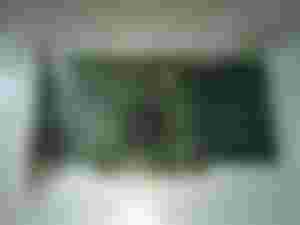
The Rage2+ comes with 4 MByte EDO VRAM. The card is more feature-complete than the Virge, it supports more type of blending modes, and bigger resolutions. In the other hand, it has no XP drivers, so in this regard, the Virge is better - ATi never bothered to support their cards longer than a few years. Due to the lack of hardware triangle setup, it will need a lot of CPU horse power to move games with higher polygon counts than a few 1000. The card was similarly priced as the Virge.
3Dlabs Permedia 2
The 3Dlabs Permedia2 was the first and last succesful OEM card of 3Dlabs. In our previous test, it was found to be on pair with the Voodoo Rush. Unlike most other cards from 1997, this supports 24 bit rendering as well. The cards come usually with 4 MByte RAM, but 8 MByte variations are also available. Mine can be updated to 8 MB, which i did. This extra memory is handy if you want to use 24 bit rendering. The card had both very good OpenGL and D3D drivers. Some cards - similarly to the Riva 128 - arrive with Video in and Video out connectors (which only work after special drivers are being installed).

Upon its release, 3Dlabs was the first company that succesfully challenged the high-end offerings of 3dfx and nVidia. The company mainly designed CAD and workstation cards, and the Permedia2 is their last chip which was frequently available with the PCI port. The Permedia 2 has XP drivers available as well, which makes it one of the best alternative of these cards. Unfortunately, the OpenGL drivers for XP are a little bit nerfed for this card, and their feature set lags behind their 9x counterparts.
Trident 3Dimage 9750 PCI
Trident was a well known 2D video chipset producer of the early 90s, but when its about 3D cards, Trident is not mentioned, for a reason. The 3Dimage 9750 was Tridents first attempt to enter the 3D game in 1997. Despite of being a little bit faster than the Virge DX, it was two years late to the game, and found itself in a market where it had to play against far bigger dogs.
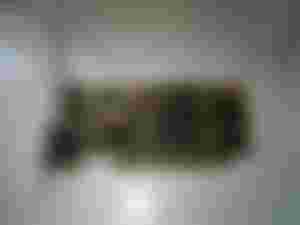
The Trident 3Dimage 9750 has 4 MByte memory (or at least mine does), and a PCI interface. It lacks 24 or 32 bit support, and OpenGL is not supported on it. It has no Windows XP drivers. Almost every trident cards are older 2D only variants, but some lucky people ended up with this 3D capable variant. Its certainly not a common specimen, but the fact it ended soeasily in my hands means it wasn't too rare either. My card is a little bit defected, and sometimes displays a few garbled lines under 3D, this will however not interfere with the test results.
nVidia GeForce FX5200 PCI
Probably the reader have not expected a GeForce FX5200 to pop up in this article, but actually it fits perfectly in this test. Its a PCI card for early 2000s computers. Unlike the previous models, which were always either used, or old stock models after 2000, the FX5200 was a brand new design. The PCI variation of the entry level FX line was released with the intention to offer the modern D3D9 API for cheap OEMs and HTPC computers. Its important to note, MX4000 and Radeon 9200 also got a PCI version, but they were not manufactured in notable numbers due to the previously mentioned factors with small demand and high costs.

The FX line was the first Dx9 card of nVidia, and the AGP 5200 was the entry level budget option. It was a very popular card, unlike the higher-end offerings of the FX cards, which were unable to compete with high end ATi's Dx9 cards. The FX5200 usually offers a 64 bit memory bus with 64 MByte DDR memory. 128 MByte variants also exist. The card was released in 2003. It fully supports Windows 98 and Windows XP as well. As being a newer card, its optimized for newer and stronger processors, but when using older nVidia drivers, it can be used without too many problems even in an overclocked Intel Pentium 1 MMX. Tho, to unleash the performance of the FX5200, it requires a CPU above 400 MHz. For example when the card is used in a Socket7 motherboard with a 200mhz-ish CPU, the games are might will be below 20 fps even if they should run much faster. As this is a DX9 card, it was the only PCI card of this era which was produced in a notable quantity, which allowed people to actually buy it. It was not easy, as it was not directly sold to the public, so you had to find a trader to sell it for you. Internet trade in 2003 was not like nowadays, it was a big hassle to find a trader and get the card, but it was possible. The price of the card brand new at the end of 2003 was about $150, compared to the $100 of the AGP version, which was not extremely expensive, but that $50 back then could have bought you a new motherboard instead in some cases. The FX5200 PCI card price slowly decreased to about $80 and was floating there, even when the AGP version became available for $10-20.

Specifications. Click on the image to open.
The test setup
The board i will feature in this test is an early VIA EIPA board. The VIA EIPA boards originally got released in 2003, and the brand continued to exist since the end of that decade. The early variations used SD RAM, but mine has DDR on it. I usually keep an 512 MByte module in it. The board tends to beep out all the RAM i putting in, the one i currently keep in it works very well in it since i got it. The VIA EPIA motherboard was considered very small in that era, a PC at this size was considered cutting edge. The entire motherboard consumes around 20W of power on its own, including the CPU. It has IDE ports, floppy controller, an integrated video chip, and USB ports as well. A standard ATX power supply can be connected to the board. No AGP ports, of course.

The integrated graphics
The EPIA has an integrated S3 UniChrome Pro. This can grab up to 32 MByte memory from the system RAM. The card is a new revision of the Savage 2000, it supports Direct3D 7 with disabled T&L engine. This chip is a relatively muscular example of early 2000s integrated graphics chips (its probably the strongest of its kind) but the disabled T&L unit, combined with the small memory bandwidth is still going to hinder the performance.

The S3 Savage 2000 in its discrete AGP video card form (which is basically the ancestor of this chip) performs around the Voodoo3. This chip will represent one of the strongest possible integrated graphics chipsets at the time, if we not count specialized and expensive nForce chipsets with integrated GeForce chips. But those had AGP anyway. The S3 UniChrome Pro supports 32 bit rendering, large textures, and has mature Windows XP and Win9x drivers as well. This EPIA board has only a VGA connector, some may have analog TV out connectors as well.
The test CPU
Instead of using an Intel or AMD CPU, the board has VIA's own integrated x86 CPU, the VIA C3. In the mid 2000s, VIA CPUs became very popular in low-power systems. This CPU runs at 666 MHz, and requires no heatsink. The market share of VIA grew a lot after they released the stronger C7 CPU, which is much faster than the C3 on the same clock speed, however, the earlyer or low-end models still used the C3 CPU. This chip represents this era quite well. The CPU supports the MMX and SSE instruction set. The VIA C3 CPU at 666 MHz (133*5) is approximately equivalent to an Intel Celeron at 433 MHz, so its certainly not a speed beast. To compensate for this, i will try to overclock the chip (this can be done from software). After i add a cooler to the board, i hope i can reach at least 800 MHz (133*6).

Picture: putting together the test system.
After searching for a proper 20pin ATX power supply that i could fit, i decided to install Windows ME, as that had the potential to be compatible with all the graphics cards planned for the test. The system turned out to be stable at around 1200 MHz, which is a very nice result.

This clock speed was achieved with 9x multiplier at 133 MHz fsb, and i used via setfsb to change the multipler. At 10x, the system crashed, so i settled with 9x, which should be equivalent to a Coppermine based Pentium3 - certainly giving enough CPU power to unleash the potential of these cards.

Collin Mcrae 3
This is a car racing game, which was made in 2002. Its the sequel to CMR2, which was considered very hi-tech for its time. The third version uses a different rendering engine, and it needs a more modern graphics card to be able to start. Despite it was released in 2002, it simply refused to start on pre-2000 video cards, making it incompatible with basically everything that isnt cutting edge. The game would might offer better compatibility under XP, i haven't tested that. I tested the game in 640x480.

As we can see, everything, except the FX5200 and the integrated UniChrome failed to run the game. Only the FX5200 produced fluid frame rates, the game on the UniChrome was quite unplayable. This game was a total disaster for all the cards.
Crusaders of Might and Magic
This is a very nice TPS fantasy game. It features a knight who escapes from a dungeon, after evil demons overtook the world. The game has some RPG elements, but its more like a very linear TPS swording simulator. Its enjoyable regardless, but i miss the typical RPG-type non linear gameplay. The game was released in 1999, but it has a quite heavy demand.

Every card managed to start the game. On the Trident, on the Virge and Rage2 card, the game was totally unplayable, and the Trio3D was also unable to produce nice experience (these cards are designed with 320x240 and 400x300 in mind, and the game was tested in 640x480 - they might would work well on smaller resolutions). The Voodoo Rush was disappointing, it only managed 12 FPS. The first card which produced enjoyable game play was the Permedia2, but some lighting effects were missing. The Riva, the UniChrome, and the FX5200 was 30-35 fps. Surprisingly the Voodoo3 almost reached 80 fps, which is very impressive.
Disney's Donald Duck - Quack Attack
I bet you didn't expected a wild Donald Duck game to exist from this era. I haven't expected it either, it got recommended to me by friends, who attempted to run this game on a modern system.

The game looks very lightweight and simplistic, as it doesn't involves too many graphics effects, and it was seemingly designed for casual gamers. The game is a 3D platformer. The game was released in 2000, and it indeed requiers a 2000-ish machine to run.

Again, on the Trident, on the Virge and Rage2 cards, and on the Trio3D, the frame rate was very poor. It would be likely playable on them in 320x240. The Permedia2 and the Voodoo Rush barely reached enjoyable frame rates, and hovered below 20 fps. From the older cards, only the Riva128 managed nice frame rates on the card. The rest of the cards managed around 30 and 35 fps, including the FX5200, the Voodoo3, and the integrated UniChrome.
F1-2002
As the name suggests, this game was released in 2002. It is a quite nice, partially arcade-ish style F1 simulator, which is notable to be quite CPU demanding. I have tested this game previously, so i don't expect to be able to run on DX5 era graphics cards.

Indeed, the game was only start up on the two newest cards. The integrated UniChrome, and the FX5200 produced playable frame rates, the FX5200 was notably better. The UniChrome also managed to make the game enjoyable. The resolution used was 640x480 once again.
Kyodai Mahjongg
This was a popular game for PC casual gamers in the early 2000s. The game have a DX7 version, an OpenGL version, and a DX9 version as well. For this test, the DX7 version was used, to offer the best compatibility. The game features various type of mahjongg games, and a chilling midi music, and its very entertaining. This version runs in a full-screen window, and the game was tested in 800x600 desktop resolution (16 bit).

This game managed to be playable on all graphics cards. Surprisingly, the Voodoo Rush was the slowest with 26 fps, and even the Rage2, Trident, and Virge cards outperformed it by exceeding 30 fps. The integrated UniChrome even exceeded 100 fps, and the Voodoo3 even reached 200 fps. The FX5200 managed almost 300 fps. This type of windowed 3D boardgame for the PC are a specimen to prove the viability of the entry level Rage and Virge-class graphics chips in 1996 and 97. These games caused 3dfx a big headache before the Voodoo3 line - as we can observe how badly the Rush behaves itself when it mets this game.
Midtown Madness
This was a game released by Microsoft, it was very popular in schools, as it was lightweight on the computer. It even had a software rendered mode, which allowed the game to run well without a 3D accelerator. The game is a precursor to the GTA series, however, there are no people here to jump in and out from the games, its just a city-wide car simulator. Its quite funny to play.

The Trident card was not able to render this game, the game produced a white screen, and it was unplayable. The Rage/Virge/Trio3D cards produced slideshow in 640x480 again (but keep in mind, they would run well in 320x240). The Permedia2 and the Riva128 were trading blows around 20 fps, running the game playable, however, the Permedia2 was seemingly got bothered from the smoke effects. The Unichrome, the Voodoo3, and the FX5200 were able to run the game at 40 fps, which was probably means we got hit by a CPU limit around this frame rate.
MotoGP2
This is a motor racing game which was released in 2001. The game was very CPU and GPU heavy. Back in its days, no computer was able to play this game fluidly, only the cutting-edge technology was enough for it (CPU-s around 1.2 GHz or above, with the latest high-end GeForce3 cards).

MotoGP2 with unichrome: extra low graphics settings
Its really a shame, but the game was considered a visual miracle in its time, one of the first games utilizing motion blur.

Only the Voodoo3, the UniChrome, and the FX5200, but all of them was a stuttering mess at 8 fps. The game probably disliked the C3 processor, as the FX5200 should have been at least semi playable. So this is most likely the fault of the game itself, but as we see, this config, even with a relatively expensive video card in it, was unable to make this game run well.
NFS Hot Porsuit 2
This game was one of the worst Need For Speed games. Bad and boring tracks, bad graphics, high computer demand, boring story, and bad experience in overall. It was so bad, people tried to sell it to me their discs for like $1 all the time. Even the cars are boring in this game.

Only three video card managed to run this game, the Unichrome, and the Voodoo3 were fighting around 20 fps. The Voodoo3 was producing some strange texture bugs. The game was playable on them, but was not a very good experience. The FX5200 managed to run the game without an issue, around 30 and 40 fps.
F22-Lightning3
This was a jet fighter simulator - more like an Arcade game - and i have already tested this game, so the results are not going to be surprise.

The Rage2, Trident, Virge struggled to reach 10 fps, and the Trio3D reached it, but still producing very anemic 12 fps. The Voodoo Rush and Permedia2 struggling to reach 20 fps, but i consider this game playable on them. The FX5200 only reached 24 fps, which is unusually low, but indeed fluid. The Riva128 and Unichrome were around 30 fps. The Voodoo3 was the absolute winner at 60 fps, due to its Glide mode.
Postal 2
Postal 2 is a criminal simulator from 2003. Its like GTA, but there are no cars, all the events are taking place in a small town. Its a very funny game, its recommended for those who just want to get rid of some steam. Unfortunately its quite heavy on the computer, and requires a CPU above 1 GHz to be enjoyable.

Again, only the three newest video card was able to start this game. The Voodoo3 and Unichrome were producing frame rates below 10 fps, making the game very unplayable. The FX5200 manage to run this game at 13-20 fps, which was more playable, but still far from being called a good experience.
Quake 3
The Quake3 was a popular first person shooter from 1999, and people were very frequently playing them on LAN parties. The game has no story - it has various levels, where people can fight against each other.

The game is based on OpenGL, and despite there are plenty of OpenGL wrappers available, on my ME setup none of the wrappers were producing good results, so the Rage2, the Trident, the Virge and the Trio3D cards were not able to produce any numbers. The Voodoo Rush, the Permedia2, and the Riva 128 managed to be between 10 to 20 fps, which is not comfortable for this game. The UniChrome, the Voodoo3 and FX5200 were producing fps numbers above 40, and the FX5200 was the absolute winner of the test.
Screamer 4x4
This offroad racing game was popular in west europe, and got released in the end of 2000. The game supports D3D, OpenGL, and Glide. I have tried the demo version, which doesn't includes the D3D version, so it was limited to OpenGL and Glide. I ran the game in 640x480x16 and here are the results:

The Rage2, the Trident, the Virge and the Trio3D having no OpenGL support, and for some reason they failed to output picture with any of the wrappers on this configuration. The Riva 128 was able to start the game, and run it below 15 fps, which was not a pleasant experience. The UniChrome was very slow here, peaking at 15 fps. The Voodoo Rush was able to push this game at 20 fps thanks to the Glide API, but the graphics was full of glitches:

The Voodoo3 was finally bug free, and managed 25 fps. The FX5200 almost managed 30 fps, and the game was fluid on it.
Tony Hawk's Pro Skater 2
Tony Hawk 2 was a very popular sport game, released in 2000. The game is very lightweight on the CPU - can pretty much run on anything above 400 MHz - and it has a well optimized graphics engine as well. I remember playing this game on plenty of configurations.

Unfortunately, the Virge, the Trident, and the Trio3D were unable to start the game. Which is even worse, the newest cards in the test also failed to run the game. The FX5200 and the UniChrome both failed to start the game. This is probably the fault of the game engine, and can be fixed by applying a patch. This was however the original demo version from 2000s, and i had no patch at my hand to fix this issue. The Rage2 was able to start the game, but it was not able to reach 10 fps. This game would be likely playable on it at 400x300 or below. The Voodoo Rush struggled to reach 20 fps, and the first card which was able to run this game at fluid frame rates was the Permedia2. The Riva128 reached 30 fps, and the Voodoo3 reached 40 fps.
Tomb Raider 2
I know this game is from 1997. I actually wanted to test its sequel, but somehow i ended up with this version due to a mistake. If i tested it already, there are no point to cover the test results out, so here are the expected performance numbers:

The Virge, the Trio3D, the Trident and the Rage2+ was between 10 to 20 fps. I would guess the Rage2+ would run this game well in 400x300, the rest three would need 320x240. All other cards got maxed out at VSYNC as far as i can tell. At least every card was able to run this old game.
Unreal 2003
This is when the Turnament indeed became Unreal, and no one was interested in this game any more. In 2003 people were not much interested in these type of games. Anyway, its era-correct, it was an interesting specimen to see, how it will behave on our old PCI graphics cards, if they can even start it up:

The Voodoo3 and the UniChrome were able to start the game, but the performance was very bad on them. The FX5200 reached 40 fps, other cards were not able to start this game at all.
The final verdict
The integrated graphics cards after 2000 were usually fast enough to outperform the older first and second gen 3D graphics cards. The S3 Savage based UniChrome chip washed the floor with the first gen Virge and Rage2 cards, and was even faster than the Permedia2 and Riva 128 cards, usually beating the Voodoo Rush as well. The UniChrome is not just fast, but it has good compatibility. From 15 games tested, the UniChrome was able to start 14 games. In contrast, the Voodoo Rush managed to start only 9 of them, and half of them were stuttering. The Voodoo3 managed to start 13 of these games, and most of them ran well, however, not too much better than the UniChrome would run them. The Permedia2 was only able to run half of the tested games, and the performance was very poor. The Riva128 managed to run 9 games, and the performance was very similar to the Permedia2 in most cases. The Virge DX only ran 6 games, and it was a stuttering mess. The same is true on the Trio3D. These cards are only suitable for gaming in 400x300. The Trident 3Dimage 9750 had the worst compatibility, only being able to start 5 of the games. The performance was similar to the Virge. In terms of compatibility, the Rage2+ outperformed the Virge DX by just one game, and managed to run 7 of them - in terms of performance, it was similar to the Virge. The GeForce FX 5200 ran 14 from the 15 tested games, most of them ran with fluid frame rates.
The average FPS of all games
When counting an average FPS, the VirgeDX is the slowest card. If a game won't start, it is being counted as 0 fps. The Trio3D, the 3DImage and Rage2+ performs equally bad. The Voodoo Rush, the Permedia2 and the Riva128 are cards only allow some games to run at acceptible frame rates.

The third best chip of the test is the integrated UniChrome. Despite being integrated, it performed far better than what i expected from it. It had very good compatibility, and the games it was able to start, usually ran at acceptible performance. The performance may could be rised with carefully selecting RAM timings, or better ram module for the system as well. The Voodoo 3 outperformed the UniChrome by 30%, however, the Voodoo3 can not start newer games it seems, so putting it to the computer wouldn't help too much.
The GeForce FX 5200 is a real beast, being able to run both the older and newer games, and the frame rates were usually very good on this card. It produced the highest average FPS as well, and it could run the newer DX9 based game titles.
Now i have the answer
You had a computer without an AGP slot after 2000, and you wanted to play some games. You were able to buy a few older PCI graphics cards with PCI support. Did it worth buying it? If you already had a Savage or SiS 3xx based integrated video, then absolutely not. The 2000s integrated graphics card simply outperformed all the early PCI cards. If your integrated graphics was too old (first gen 3D, or without 3D capabilities at all) then you had a very bad luck. The only card which gave you an acceptible experience is the Voodoo3 PCI, which still can't run most of the post-2000 titles.
Except the FX5200. The PCI version of the FX5200 is a good card with a lot of memory, and with supporting modern OpenGL and DirectX. It was a better, modern, capable alternative to the integrated graphics cards, and outperformed the 3dfx cards as well. The FX5200 is usable even for newer titles of 2004 and 2005. The price was however too high, so the buyer had to carefully consider if he buys the FX5200 PCI, or upgrades the motherboard instead.



